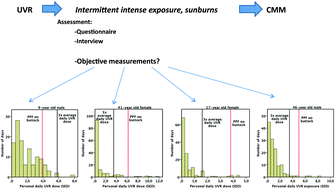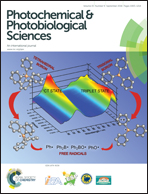Defining “intermittent UVR exposure”
Abstract
Background: Cutaneous malignant melanoma (CMM) has been associated with “intermittent UVR exposure”, which in previous studies has mainly been assessed by retrospective questionnaire data. Further, there is no uniform definition of the term “intermittent UVR exposure”. Objectives: We aimed to define and quantify “intermittent UVR exposure” by an objective measure. Methods: A broad study population of adults and children had data collected during a summer period. Data were personal UVR dosimetry measurements, from which the number of “intermittent days” was derived, sun behaviour diaries and retrospective questionnaires. Two definitions of intermittent UVR exposure were tested: (1) days when UVR dose exceeded 3 times individual average daily UVR dose, and (2) days when UVR dose exceeded individual constitutive skin type. Measures of nevi and lentigines were used as surrogates for CMM. Results: Using the first definition based solely on UVR dosimetry data we found 1241 “intermittent days” out of a total of 17 277 days (7.2%) among 148 participants. The numbers for nevi and lentigo density were significantly predicted by the number of intermittent days (R2 = 0.15 and R2 = 0.40, p < 0.001). The corresponding numbers for prediction of nevi and lentigo density by retrospective questionnaire data was lower (R2 = 0.11, R2 = 0.26, p < 0.001). Conclusions: We introduce a well-defined objective measure of intermittent UVR exposure. This measure may provide a better prediction of solar skin damage and CMM than retrospective questionnaire data.


 Please wait while we load your content...
Please wait while we load your content...